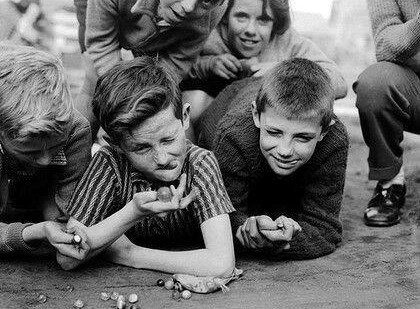A few months ago, I wrote about Joe Vescio, a lifelong Fultonian who was part of a large Italian farming family. Joe’s no longer with us, but he left us an essay about his life to enjoy. He called it “The Good Old Days” and today’s column is inspired by Joe’s memories of how kids used to play.
We baby boomers are well aware that what children consider enjoyable today is vastly different from when we were young. Many of us regularly complain about kids spending too much time staring at a screen, whether it be a TV, computer or cell phone. But rather than focusing on complaining, Joe told stories about how kids played in the good old days.
“We had to be original and think of ways to amuse ourselves without getting into trouble,” Joe wrote. “One of the ways we amused ourselves was to play marbles. I mean the marbles made out of clay. We were so poor we couldn’t afford real alleys, which were glass marbles with fancy colors inside.”
Joe and his buddies created a whole world out of those marble games, which even made schooldays fun. “We used to play with them on the way to school,” Joe explained. “It was a very simple game; all you had to do was toss a marble and then your opponent would have to either hit your marble with his toss or come within a hand span to claim your marble. You would be surprised how many you could win or lose by the time you got to school.”
The fun didn’t stop when Joe and his pals arrived at their destination. “We would usually get to school a little early and with a small twig make a circle in the play yard. Each player would toss in the same number of marbles and then we would take turns trying to shoot the marbles outside the circle. Whatever each player got outside the circle were his.”
Marbles never was my game of choice, so I wasn’t sure why winning as many as possible was important. But, as Joe described it, marbles were treasures to protect: “The fancier they were, the more valuable. We had to exchange five clay marbles for one glass alley. Then, of course, there was the steely, which was a metal ball taken from ball bearings and could be of various sizes. Those were the ultimate, and sometimes you had to give up to ten or twenty glass alleys to get one steely.”
Joe concluded his memories of playing marbles with a comment that connected his Vescio family to my family. “All of us kids had an old cloth salt sack filled with marbles,” Joe said, “and I remember guarding them with our lives.”
Joe’s mention of a salt sack reminded me of a talk I had with my dad, Silvio Farfaglia, shortly before he passed away. Dad was telling stories of his life, including his younger years right around the time our country was suffering from The Great Depression. Like many during that time period, Dad’s family was struggling to make ends meet. Having fun wasn’t the responsibility of parents; it was up to kids.
“We’d go to school all day long and then congregate in the streets after,” Dad told me. “For play we’d take the old salt bags—back then, salt came in a bag—and we’d stuff it with leaves. That’s what we used for a football. If we wanted to make a scooter, we took a couple pair of old roller skates and a piece of wood. We’d play hockey on the pond, with an old stick and a stone for a puck; none of us had ice skates. We invented a game where we took an old clothespin and sharpened the end and threw it like a javelin to see who could throw the farthest.”
Dad made it sound like part of the fun in those games of challenge was scavenging for the right materials. Here’s what Joe needed for a game he called megly peg: “We used to cut a four-inch piece from an old broom handle, then taper about one inch back on each end to make a peg. Each player would have a stick about eighteen inches long, probably cut from the same broom handle…The object of the game was to hit the end of the tapered peg with the longer stick to make it leave the ground toward the center of a circle.”
Like my dad, Joe and his friends used whatever they could find around the house for their games. “We’d get a piece of shingle about two inches wide by one foot long and make a small hole in one end of it and tie a string on the hole and twirl it around you to make it sound like an airplane,” Joe wrote. “We would tie string about eighteen inches long on each of a handkerchief’s four corners and then tie them to a small rock…then toss it as high as you could and watch our parachute come down gradually.”
For a game called “hoops” Joe needed a large circle. “The only problem,” he recalled, “was that we were never able to get a good round hoop; all we were able to get were barrel hoops and they were slightly tapered and made it a little more difficult to control, but somehow we were able to overcome all obstacles…”
Overcoming obstacles to have fun. That’s not something you hear much of today, when most toys are packaged and ready to play. It inspires me to remember how Joe and my dad’s generation tackled those problems, because no matter what, as Joe pointed out, “we did have fun.”
